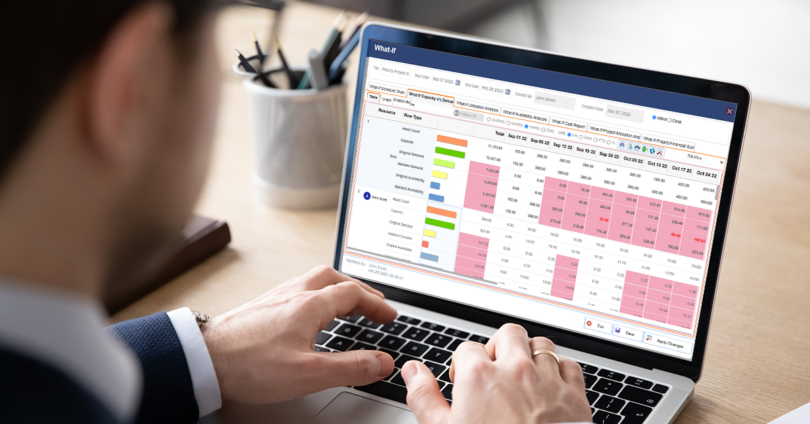“50% of all projects fail due to a lack of proper risk management, and 85% are delayed because risks were not identified in time.”
These statistics show how essential resources are to deliver projects within the stipulated time and budget. Lack of appropriate resource management can lead to risks such as skill shortages, reduced productivity, etc., that can deflect the project’s success.
Moreover, these risks will derail the project quality and lead to client dissatisfaction. Hence, before kick-starting the project, managers must anticipate resource-related bottlenecks and find solutions to ensure successful project completion.
This blog lists a few strategies to pre-empt the risks and how Saviom’s resource management software can help managers combat them effectively.
Before that, let’s understand the various resource-related risks.
Let’s begin!
Common types of project resource risks
Resource risks can be unexpected events that adversely affect the project and the business. Some of the major resource risks involved in project management are:
Shortage of skilled resources
Skill shortages may occur due to inaccurate forecasting of resource demand, leading to the unavailability of critical workers for project initiation. In addition, it’s challenging for managers to procure niche skilled resources on short notice. This results in last-minute firefighting and wrongful hiring, impacting the quality of the project.
Cost overruns
Project costs may shoot up for various reasons, including the procurement of high-cost resources. Sometimes, a sudden change in the project scope may require additional resources, which can cause a budget overrun. In addition, allocating over-skilled workers or last-minute reshuffling of resources can inflate project costs.
Productivity issues
Scheduling resources for projects that don’t match their interest and skills, setting impractical deadlines, and sub-optimal utilization will lead to reduced productivity and low morale. When resource skills are not used appropriately, it will impact the project’s quality, performance, and timelines.
Employee burnout
When managers assign work without proper visibility into the resource availability, it will lead to double bookings and over-allocation, resulting in stress, burnout, and eventually unplanned attrition. This causes delays and compromises project quality.
Absence of backup planning
When crucial resources suddenly resign or quit a project midway, it becomes difficult to replace them. Without a backup plan, the demand gap can widen and bring the project to a grinding halt. In addition, the absence of key resources will increase the workload for the existing employees, impacting the quality of the deliverables.
As we have understood some of the essential resource-related risks in a project, let’s dive into the techniques to reduce them.
Ways to effectively combat project resource risks
To reduce the resource risks in a project, the manager must be prepared in advance with the best course of action.
Enlisted below are some of the best strategies to reduce resource risks:
1) Foresee project demand to identify skill shortage/excess
When a pipeline project reaches the approval stage, project managers must estimate the demand and place the resource request accordingly. Based on this, the resource managers will assess the requirements, examine the existing resource pool, identify skill shortages/excess, and take appropriate measures.
They can fulfil the skill shortages by upskilling/ training resources or using an out-rotation and backfilling strategy. Moreover, the manager will have sufficient lead time to hire the right skills. Likewise, if there is excess capacity, managers can bring forward the project timelines, assign them to other projects, or sell the excess resources. This will eliminate the wasteful hiring/ firing cycles and ensures the project starts on time.
2) Hire the right mix of permanent and contingent resources
Based on the project needs, managers must ensure they are equipped with the right mix of resources well in advance. For instance, in an IT project, there is a requirement for a cybersecurity engineer to provide security protocols. Managers must first look into internal channels to identify these skills. If these skill sets are unavailable, they can hire on-demand resources for short-term requirements.
Likewise, for a long-term project, they can hire a permanent resource. Therefore, maintaining a balanced mix of permanent and contingent workforce allows organizations to fulfil dynamic project requirements while preventing project delays and budget overruns.
3) Leverage cost-effective global resources to maintain profitability
Managers must identify and allocate the best-fit resources to maintain project quality and control costs. For this, they need to assign competent global resources from low-cost locations. However, without enterprise-wide resource visibility, it is difficult for managers to find professionals with matching skills at affordable prices.
A high-level view of the resources and their competencies enables managers to allocate cost-effective resources across organizational boundaries. Moreover, managers can create the right band mix of junior and senior employees to reduce project resourcing costs. This way, organizations can prevent financial overruns, maintain the quality of deliverables, and enhance profitability.
4) Ensure competent resource allocation for better productivity
Managers must assign the right resources to the projects to maximize productivity. When a less experienced resource is allocated to critical tasks, it will lead to stress and burnout. Likewise, experienced resources allocated to low-priority work will lead to disengagement and low morale.
When managers have visibility into resources’ information like availability, skills, cost, interest, etc., they can assign best-fit resources to the projects. Therefore, organizations can enhance the workforce’s productivity and maintain project deadlines by ensuring competent allocation.
5) Optimize resource utilization to prevent burnout
When the workload is not distributed evenly, it will lead to over/underutilization of resources resulting in stress, burnout, and poor work quality. To avoid this, managers must distribute work based on the resources’ schedules, availability, and capacity.
Moreover, managers must regularly monitor and track the utilization levels of the resources to identify if they are over/underloaded. Accordingly, they can implement optimization techniques like resource smoothing and levelling. This will help eliminate burnout and improve the resource health index.
6) Estimate resource requirements at regular intervals
In the project planning phase, project managers estimate the workforce requirements and raise the request to resource managers accordingly. Once the project starts, the PM must re-evaluate the resource requirement at regular intervals to ensure they have adequate labour throughout the project lifecycle. For instance, the PM of a construction project initially estimated the requirement of architects.
However, during the execution stage, the PM analyzed that they would require one additional architect to accommodate the changes in the project scope. Thus, evaluating the resource requirement periodically gave the resource manager sufficient lead time to initiate hiring. This will help organizations to mitigate resource shortages effectively, eliminate costly last-minute hiring, and boost business profitability.
7) Formulate a backup strategy for critical roles
When projects are in the execution stage, and a critical resource has taken an unplanned leave, it will affect the entire project delivery. For instance, you’re developing a product that has reached the validation and testing phase. At this stage, the leading QA Engineer takes an abrupt leave. This may cause delays or even halt the project.
To alleviate risks such as employee absenteeism or sudden resignation, managers must have a backup plan to find suitable resource replacements. In addition, they must keep track of the skills and abilities of the workforce and accordingly create a succession plan for critical roles. This will help in delivering projects successfully while maintaining quality.
Having listed the methods to overcome resource risks, let’s see how advanced resource management software can be beneficial.
How can advanced resource management software help?
Resource risks are inevitable in a project landscape but need to be managed appropriately. Leveraging enterprise-grade resource management software like Saviom can provide real-time insights to reduce these risks effectively.
Here are some ways:
- The tool’s 360-degree visibility enables the competent allocation of resources based on skills, qualifications, experiences, availability, cost rate, etc. As a result, it eliminates the allocation of over/under-skilled employees to a project. Additionally, it also allows them to leverage cost-effective global resources.
- The forecasting and capacity planning feature enables managers to foresee pipeline project demand and address resource excess/shortage with appropriate measures like training/upskilling programs.
- Real-time BI reports like actual vs. forecast, and colour-coded heatmaps help managers identify the over/underutilization of resources. With this, managers can take precautionary steps to ensure even workload distribution and optimal resource utilization.
- The in-built competency matrix enables managers to track and update the skills of the resources across the enterprise. In addition, it allows companies to facilitate training programs and formulate a backup strategy for critical positions.
- The open seat feature helps managers identify and allocate projects based on the interests of the resources. This will increase the productivity of the workforce and provides more job satisfaction.
- Finally, the what-if-analysis feature helps managers to create various scenarios and anticipate their impact on projects. This allows managers to make informed decisions and mitigate resource constraints.
Final thoughts
Managing resource risks may be overwhelming in a project, but implementing the above strategies and an advanced resource management tool could significantly reduce workforce risk. Furthermore, it will help organizations boost profitability and deliver projects successfully. Let us know what techniques you follow to combat resource risks in a project.
“The opinions expressed by BizWitty Contributors are their own, not those of BizCover and should not be relied upon in place of appropriate professional advice. Please read our full disclaimer."







